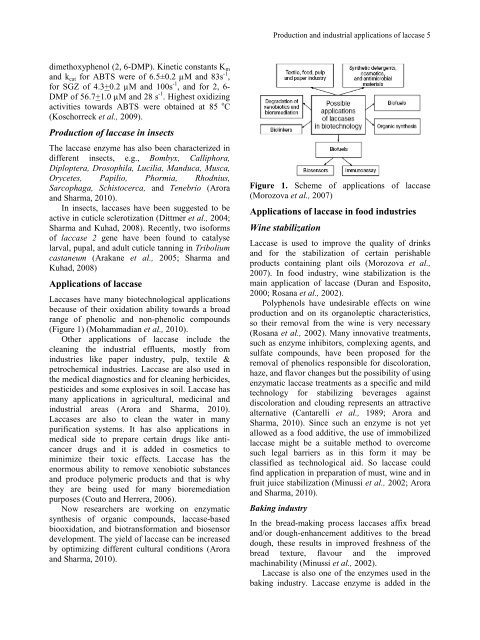10 1 Full Volume (PDF)(jcmb.halic.edu.tr) - Journal of Cell and ...
10 1 Full Volume (PDF)(jcmb.halic.edu.tr) - Journal of Cell and ...
10 1 Full Volume (PDF)(jcmb.halic.edu.tr) - Journal of Cell and ...
Create successful ePaper yourself
Turn your PDF publications into a flip-book with our unique Google optimized e-Paper software.
dimethoxyphenol (2, 6-DMP). Kinetic constants Km<br />
<strong>and</strong> kcat for ABTS were <strong>of</strong> 6.5±0.2 µM <strong>and</strong> 83s -1 ,<br />
for SGZ <strong>of</strong> 4.3+0.2 µM <strong>and</strong> <s<strong>tr</strong>ong>10</s<strong>tr</strong>ong>0s -1 , <strong>and</strong> for 2, 6-<br />
DMP <strong>of</strong> 56.7+1.0 µM <strong>and</strong> 28 s -1 . Highest oxidizing<br />
activities towards ABTS were obtained at 85 o C<br />
(Koschorreck et al., 2009).<br />
Production <strong>of</strong> laccase in insects<br />
The laccase enzyme has also been characterized in<br />
different insects, e.g., Bombyx, Calliphora,<br />
Diploptera, Drosophila, Lucilia, M<strong>and</strong>uca, Musca,<br />
Orycetes, Papilio, Phormia, Rhodnius,<br />
Sarcophaga, Schistocerca, <strong>and</strong> Tenebrio (Arora<br />
<strong>and</strong> Sharma, 20<s<strong>tr</strong>ong>10</s<strong>tr</strong>ong>).<br />
In insects, laccases have been suggested to be<br />
active in cuticle sclerotization (Dittmer et al., 2004;<br />
Sharma <strong>and</strong> Kuhad, 2008). Recently, two is<strong>of</strong>orms<br />
<strong>of</strong> laccase 2 gene have been found to catalyse<br />
larval, pupal, <strong>and</strong> adult cuticle tanning in Tribolium<br />
castaneum (Arakane et al., 2005; Sharma <strong>and</strong><br />
Kuhad, 2008)<br />
Applications <strong>of</strong> laccase<br />
Laccases have many biotechnological applications<br />
because <strong>of</strong> their oxidation ability towards a broad<br />
range <strong>of</strong> phenolic <strong>and</strong> non-phenolic compounds<br />
(Figure 1) (Mohammadian et al., 20<s<strong>tr</strong>ong>10</s<strong>tr</strong>ong>).<br />
Other applications <strong>of</strong> laccase include the<br />
cleaning the indus<strong>tr</strong>ial effluents, mostly from<br />
indus<strong>tr</strong>ies like paper indus<strong>tr</strong>y, pulp, textile &<br />
pe<strong>tr</strong>ochemical indus<strong>tr</strong>ies. Laccase are also used in<br />
the medical diagnostics <strong>and</strong> for cleaning herbicides,<br />
pesticides <strong>and</strong> some explosives in soil. Laccase has<br />
many applications in agricultural, medicinal <strong>and</strong><br />
indus<strong>tr</strong>ial areas (Arora <strong>and</strong> Sharma, 20<s<strong>tr</strong>ong>10</s<strong>tr</strong>ong>).<br />
Laccases are also to clean the water in many<br />
purification systems. It has also applications in<br />
medical side to prepare certain drugs like anticancer<br />
drugs <strong>and</strong> it is added in cosmetics to<br />
minimize their toxic effects. Laccase has the<br />
enormous ability to remove xenobiotic substances<br />
<strong>and</strong> produce polymeric products <strong>and</strong> that is why<br />
they are being used for many bioremediation<br />
purposes (Couto <strong>and</strong> Herrera, 2006).<br />
Now researchers are working on enzymatic<br />
synthesis <strong>of</strong> organic compounds, laccase-based<br />
biooxidation, <strong>and</strong> bio<strong>tr</strong>ansformation <strong>and</strong> biosensor<br />
development. The yield <strong>of</strong> laccase can be increased<br />
by optimizing different cultural conditions (Arora<br />
<strong>and</strong> Sharma, 20<s<strong>tr</strong>ong>10</s<strong>tr</strong>ong>).<br />
Production <strong>and</strong> indus<strong>tr</strong>ial applications <strong>of</strong> laccase 5<br />
Figure 1. Scheme <strong>of</strong> applications <strong>of</strong> laccase<br />
(Morozova et al., 2007)<br />
Applications <strong>of</strong> laccase in food indus<strong>tr</strong>ies<br />
Wine stabilization<br />
Laccase is used to improve the quality <strong>of</strong> drinks<br />
<strong>and</strong> for the stabilization <strong>of</strong> certain perishable<br />
products containing plant oils (Morozova et al.,<br />
2007). In food indus<strong>tr</strong>y, wine stabilization is the<br />
main application <strong>of</strong> laccase (Duran <strong>and</strong> Esposito,<br />
2000; Rosana et al., 2002).<br />
Polyphenols have undesirable effects on wine<br />
production <strong>and</strong> on its organoleptic characteristics,<br />
so their removal from the wine is very necessary<br />
(Rosana et al., 2002). Many innovative <strong>tr</strong>eatments,<br />
such as enzyme inhibitors, complexing agents, <strong>and</strong><br />
sulfate compounds, have been proposed for the<br />
removal <strong>of</strong> phenolics responsible for discoloration,<br />
haze, <strong>and</strong> flavor changes but the possibility <strong>of</strong> using<br />
enzymatic laccase <strong>tr</strong>eatments as a specific <strong>and</strong> mild<br />
technology for stabilizing beverages against<br />
discoloration <strong>and</strong> clouding represents an at<strong>tr</strong>active<br />
alternative (Cantarelli et al., 1989; Arora <strong>and</strong><br />
Sharma, 20<s<strong>tr</strong>ong>10</s<strong>tr</strong>ong>). Since such an enzyme is not yet<br />
allowed as a food additive, the use <strong>of</strong> immobilized<br />
laccase might be a suitable method to overcome<br />
such legal barriers as in this form it may be<br />
classified as technological aid. So laccase could<br />
find application in preparation <strong>of</strong> must, wine <strong>and</strong> in<br />
fruit juice stabilization (Minussi et al., 2002; Arora<br />
<strong>and</strong> Sharma, 20<s<strong>tr</strong>ong>10</s<strong>tr</strong>ong>).<br />
Baking indus<strong>tr</strong>y<br />
In the bread-making process laccases affix bread<br />
<strong>and</strong>/or dough-enhancement additives to the bread<br />
dough, these results in improved freshness <strong>of</strong> the<br />
bread texture, flavour <strong>and</strong> the improved<br />
machinability (Minussi et al., 2002).<br />
Laccase is also one <strong>of</strong> the enzymes used in the<br />
baking indus<strong>tr</strong>y. Laccase enzyme is added in the
















